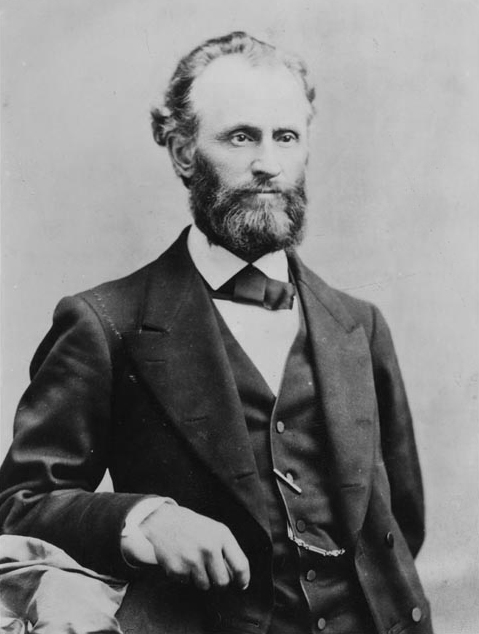
The Bragg Mine (1876 - 1878)
Dr. B. F. Bragg was a businessman and horse trader from Kentucky. In the mid-1870s, Bragg had traveled to California to sell thoroughbred horses to Lucky Baldwin.
Elias Jackson "Lucky" Baldwin was a prominent California businessman and investor during the second half of the 19th century. Lucky Baldwin was famous for breeding fine racehorses. Baldwin founded the original Santa Anita Park racetrack on his 46,000 acre Rancho Santa Anita estate.

^ ^ ^ Elias Jackson "Lucky" Baldwin
While in California, Dr. Bragg was approached by an Indian named Red Cloud who explained he used to work at the lost padres' mine in the 1840's. The Indian offered the doctor a deal. In exchange for two horses, the Indian said he would show Dr. Bragg the location of the lost mine.
Together they journeyed to the vicinity of the concealed workings but the Indian did not reveal the hidden entrance to the mine. Instead, he showed Bragg an unworked, gold-bearing seam nearby.
Bragg decided to mine, but there was a complication right from the start. The outlaw, Bronco Charlie Riley, lived in a cabin nearby, so Bragg took the outlaw on board as part of the crew. Together with Red Cloud and three Mexican laborers, they started to mine in 1876.
Working with hand tools, they dug down on an angle for about forty feet in a vein of decomposing quartz containing web and wire gold which became richer with depth.
The miners were paid by keeping what they dug out of the mine on one day of each week. The spoils from the other days were retained by Bragg who owned the mine.
However, as they dug deeper they encountered problems with water flooding the shaft. To deal with this problem, Bragg had a pump made to special order by Fairbanks Morse in New York that could be operated by mule power.

^ ^ ^ Fairbanks Morse company
Tragedy Struck
The mining continued from spring to fall for three seasons from 1876 to 1878 until tragedy struck. It is not clear who started the shooting or why, but the only survivors were the outlaw, Bronco Charlie Riley and Dr. Bragg who fled the scene on horseback.
It is believed the cause of the shootings was a single strike worth $93,000 from a particularly rich pocket. After the murders, the mine was covered over and concealed, and the four bodies disappeared without trace.
The bodies of the four victims were hidden, but not in the mine itself as the legend claimed. Annie Rose found the skeletons of the four murdered Bragg miners 52 years later in September 1930.
While drunk, the outlaw Riley boasted in public about the incident admitting to carrying out the murders. A few days later Riley himself was shot and killed. Without any witnesses, the exact circumstances of his demise are unclear.
The Bragg operation was apparently a rich mine, as records from the old Hellman Bank in Los Angeles showed Bragg made deposits of around $800,000.
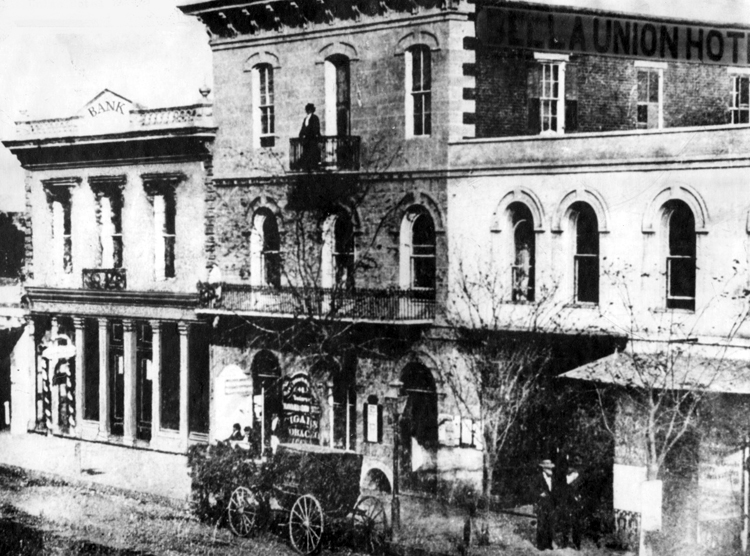
^ ^ ^ Hellman's first bank, Hellman, Temple and Company, opened in the building on the left in 1868. It stood next door to the Bella Union Hotel, one of Los Angeles' first brick buildings.
Bragg had become ill with tuberculosis and never reopened the mine. Dr. Bragg died in Los Angeles in 1915. Despite his considerable wealth,
he is said to have died a "poor man". Annie Rose Briggs described the Dr. B. F. Bragg mine in one of her poems:
Full thirty years were past and gone, and Red Cloud was a man,
With still a love of horses great, as strong as any can.
And he saw some he liked full well, of gallant racing blood,
These horses he just had to have, in spite of mine or flood.
He promised clear he'd show a mine, The Lost Horse Mine renowned,
For after all, he reasoned well, it was the mine he found.
And twas his own beloved horse, had given it the name,
And he had done a lot of work, to bring it's wealth to fame.
And who shall say he reasoned wrong, as secret led the way,
Going North from Newhall with his pack, a warm and sunny day.
He pointed at the foot of hill, and told the men to dig,
At twice the height of any man, the Gold was showing big.
A shaft they sunk for forty feet, and there a tunnel grew,
And getting deeper all the time, to get the depth he knew.
And all went on as fair as day, a fortune came and went,
Each summer taking out the Gold, each winter having spent.
Three summers came and passed away, some falling entered in,
And greed and envy showing up, and led to deadly sin.
For gentle lives were taken there, and cast out in a breath,
Nor reason, nor compassion, then for such a sudden death.
Four lives went out with out a prayer, and only two lived still,
The one who did the awful deed, and one West o'er the hill.
And neither one could venture back, to that full haunted spot,
For many years it seemed to be, a place that God forgot.
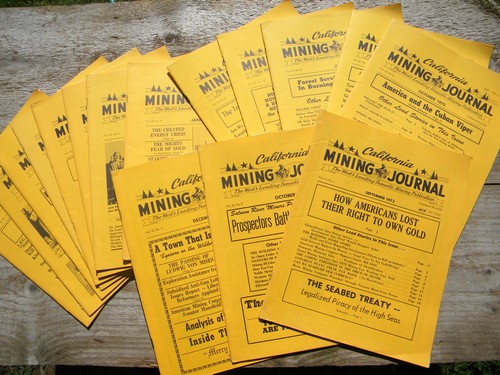
Howard D. Clark, a respected author on the subject of lost mines, investigated the history of the Bragg mine.
In The California Mining Journal in May 1963, Howard Clark concurs with Annie's story: "Considerably skeptical, Bragg accompanied the Indian on the long trek
to the scene and heard something of the operations once carried on. As it turned out, the Indian in his younger days had been a foreman of sorts for the early miners
and as interpreter he had received a good education from them. True to Indian tradition, technically at least, he would not point out any concealed shafts or tunnels
but indicated a stringer which would lead into the same king of enrichment."
"But at the outset it was unavoidable that another member had to be included in the party. A fugitive from the law was living in his shack on a hill almost overlooking
the canyon, safe in such an isolated hunter's paradise. In the interests of secrecy he had to be cut in with them."
"They had worked with only hand tools into an eleven foot vein of rotted quartz and granite where the rock could be shaken from web and wire gold."
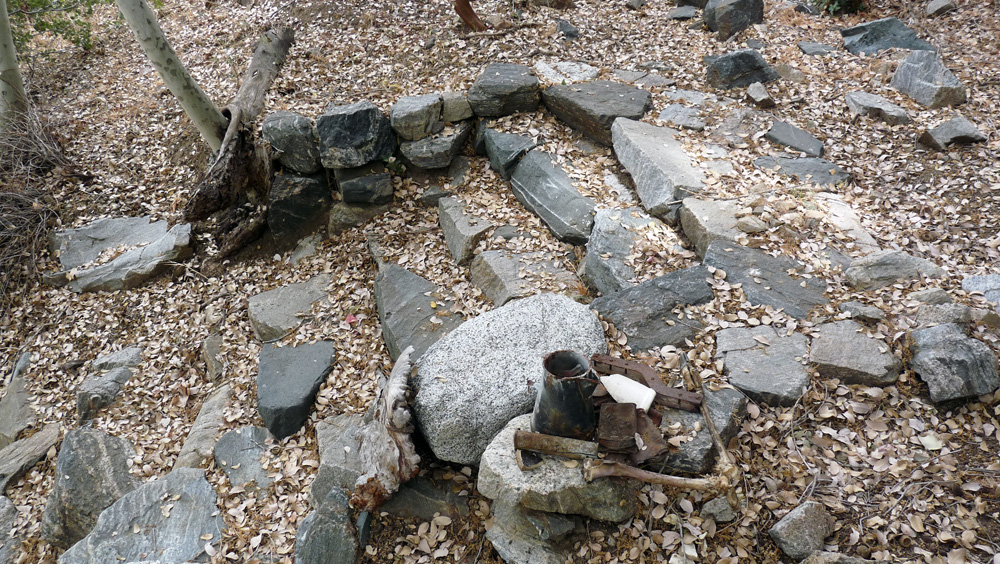
^ ^ ^ This is believed to be the ruins of Bronco Charlie Riley's cabin near the Bragg Mine. These rock steps are the most visible feature remaining today.
Annie Rose said she first heard stories of the old Bragg mine from her father and also from visitors to their family business, Rose Station, a stage-coach stop founded in 1873 in the San Joaquin Valley below the Grapevine.
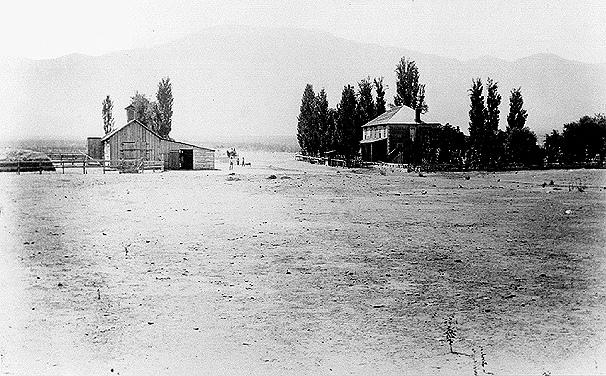
^ ^ ^ Rose Station was a stockmen's headquarters, post office, polling place, and a center for social activities in the Tejon area (operated between 1873 and 1942). This photo was taken in the 1880s.
In 1906, Dr. Bragg confided information about his lucrative 1876 gold-mining operation from 30 years earlier to a young Annie Rose who was 22-years old at the time. Howard D. Clark wrote that: "Mrs. Briggs heard Dr. Bragg's story directly from him, told as carefully as he was able to give it when there was no chance of further interest or activity by him. One of the Sutros told Mrs., Briggs that if ever found again, this mine could be the biggest one of its kind."
As reported in the Los Angeles Times on 11 June 1922, Annie Rose subsequently travelled to San Francisco "and as a result of extensive research, she found records of the mine and some data compiled by U.S. Surveyor Reynolds in 1878." (Joseph Ward Reynolds published a handbook of the mining laws of the United States and Canada in 1898 - still available in print today).

The LA Times article continued: "Since making her trip to San Francisco, Miss Rose states that she has staked a claim about the old mine which is located on a range owned by the government." Howard Clark added: "When the time came that Mrs. Briggs staked claims of her own she was included in many attempts at swindle and intimidation."
Skeletons
On 13 September 1930, Annie Rose found two human skulls in a shallow grave. The bodies were covered by a layer of large rocks and then covered over with ashes. Annie was certain they were the remains of the murdered Bragg mine workers.
After Annie reported finding the two human skulls to the Newhall substation of the Sheriff's office, they dispatched Deputy Sheriffs J.H. Lockey, N.K. MacVine, and J.H. Long to investigate the skeletal remains on 17 September 1930. The bones were boxed up and turned over to a Coroner named Nance.
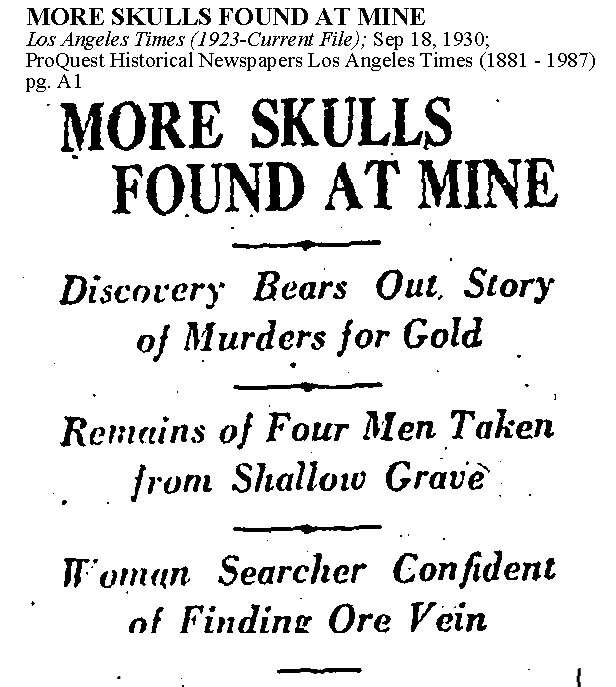
^ ^ ^ Los Angeles Times, 18 September 1930
Annie describes the location of the skeletal remains as being hidden under the Indian's "wigwam" or tepee and not sealed in the mine as the legend proclaimed. She said Broncho Charlie Riley successfully hid the bodies from Bragg.
The following is what Annie Rose described in an interview published in the Los Angeles Times newspaper on 18 September 1930:
"This was the spot where an Indian chief, one of the murdered men, built his wigwam while he and three Mexicans worked the mine."
"My father, William Rose, knew the story well. He told it to me and from the time I heard it I have searched these twenty years to
find the chief and his three helpers' remains on the certainty that it will lead me to the shaft of the Lost Padre." "The mine was first discovered by Indians in 1843. They carried gold out of here by the handfuls. The Spanish padres taught them
how to extract the gold from the ore." "Then came wars with the Mexicans and the workers left. Only one old Indian Chief survived who knew the location of the mine." "This he imparted in 1876 to Dr. B. F. Bragg, one of the colorful men of early Southern California sporting days, in return for some
race horses. The doctor directed him and his three Mexican helpers in working the mine. They would toil six days for Dr. Bragg and on the seventh were allowed to keep
all the gold they could mine. The precious metal came in almost pure form and Dr. Bragg grew fabulously rich. He died a poor man in Los Angeles in 1915." "Everything went along fine until a man known as 'Bronco Charlie Riley' - the bad man of the district - came over from his cabin
and saw the golden wealth pouring from the bore." "Because he was known as a dangerous man Dr. Bragg let Riley act as superintendent over the Indian and the three Mexicans.
He thought by letting Riley in on some of the gold he would not attempt to rob the workings." "But on the day the $93,000 was known to have been mined the Indian and three Mexicans disappeared. Riley said they deserted.
He evidently had buried the bodies of the four under the floor of the chief's wigwam - the only place Dr. Bragg did not search." "The doctor's health broke; he feared Riley and never was able to return to the mine. Riley tried to get someone to help him - he
was unable to get the ore out alone but no one would trust him." "The Indian who had been present when the padres had blessed the mine at the beginning, laid a curse on the diggings, legend has it,
that would stay in force should he be killed and his body hidden." "Riley, a superstitions man, feared that the curse would keep him from extracting the wealth. Consequently he obliterated all trace
of the opening by starting landslides. He felt some day he could get help, but he got drunk one night in Newhall - now the site of Saugus - and boasted he had paid
off the four with bullets." "A few nights later he was shot to death. Dr. Bragg still held the secret of the mine's location, but he wanted to keep it until
he recovered his strength. He died without ever coming back. His description to me of the bore's location, however, has led me to continue the quest all these years." "Finding the four men's remains shows I am on the right track. I feel that the spell is broken. The Lost Padre, I hope, will be opened up
again soon. Dr. Bragg told me the remaining wealth in the ledge could not be estimated." In a Los Angeles Herald article in 1892, Bragg's appearance was described as follows: "Doctor Bragg is a half-breed Cherokee Indian,
who wears enormous gray mustachios and a nine-inch goatee, the effect of which he heightens by the liberal use of mutton suet." Another article in the Los Angeles
Herald mentioned his "..extraordinary gray goatee nearly a foot long, and as stiff as a railroad spike by the plentiful application of dry soap." Additional source As a teenager, David Wasdahl helped Annie Rose on her mining claim. This was in late 1939 and early 1940 when he was fifteen years
old. In a letter he sent to the Ridge Route Communities Museum & Historical Society in Frazier Park in August 2007, David recalls stories told to him by Annie Rose
and others about this dramatic event. David Wasdahl writes: "Legend has it that Bronco Charlie did the killing and Dr. Bragg raced for the safety of Castaic and
Los Angeles. Mrs. Cordova, who had the ranch next to ours in Castaic Canyon, once related to me how Dr. Bragg, riding wildly down the canyon on his horse, was
shouting that Bronco Charlie had killed everyone at the mine. Mrs. Cordova wasn't old enough to witness this herself, so I assume it was related to her by an
older relative." "Being uncertain about who would be blamed for the death of the miners (himself or Bronco Charlie), Dr. Bragg sailed to the
Hawaiian Islands. After a considerable period of time, his money running low (perhaps from betting on horses) and his failing health, Dr. Bragg returned to the
California southland." "He contacted Annie Rose's father, who was stage coach station master at a station between the Grapevine and Bakersfield, and had
made arrangements for him to re-open the concealed mine. They formed a partnership. He gave Mr. Rose a map and instructions on how to find the mine but the years of
rainstorms, landslides and heavy growth of brush had served to further conceal the mine. Dr. Bragg was too arthritic to ride a horse any longer so he couldn't make
the trip up to the mine site. All he could do, from time to time, was to give Mr. Rose further instructions on how/where to find the mine. In the end Mr. Rose was
unable to find the mine and the quest was passed on to his children, Annie and Billy." ^ ^ ^ A young David Wasdahl aged 15 when he was helping Annie Rose with prospecting. MAY 1939 Annie's poem entitled, MAY 1939, describes the re-opening of the Dr. B. F. Bragg mine. There is an accurate correlation between what she writes in the poem and the known historical facts.
The Bragg mine was worked from 1876 to 1878. Annie's reference to "sixty years" matches the year the Bragg mine was concealed. The "four murdered men" is a reference to the miners that the outlaw Bronco Charlie Riley had shot, namely Red Cloud and three Mexican laborers.
Here is an excerpt from the last part of her poem, MAY 1939: 'Twas searching for the Padre Mine, the search is over now, This is a curious poem because it sounds like they are opening the lost Bragg mine. As far as I know, Annie never found the Bragg
Mine. So it seems she wrote this poem imagining the opening of the old mine rather than this actually happening in reality. The California Mining Journal in May 1963 attested to the mine's richness:
"This monster gold bearing vein was 60% gold."
Howard D. Clark sums up by saying: "Much convincing evidence exists to indicate that the Padre is American mining's richest sleeper".
^ ^ ^ Book published by Howard D. Clark in 1946. He was an authority on lost mines. Peter Gray
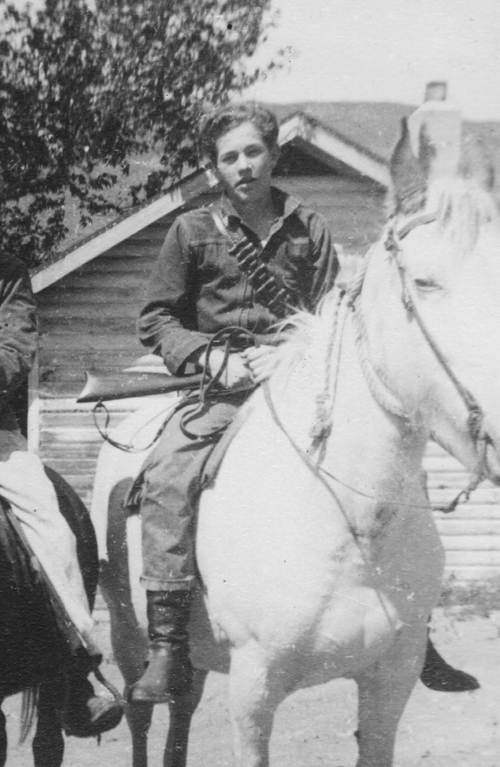
It's rock by rock and clearing out, it's patient work and how.
For picks wear down and backs get tired, and weary days go by,
And those who should be helping there, they do not even try.
Perhaps we'll work it out alone, maybe new help we'll see,
To open up the tunnels old and help build history.
For it's a very famous Mine, and as it opens more,
the romance of a hundred years, we're standing at it's door.
"And now its door is opening slow, to open up a page,
Closed sixty years and more ago, in blind inhuman rage.
And what we find or what we see, we'll try with gentle hands,
To let a greater power than ours, preserve the iron bands.
And what could show a greater hurt, than those four murdered men,
Who went down in that darkened hole, and no're came out again.
Is it their ghosts we hear at night, clear up along the trail,
Or is it just the restless flight, of some young mountain quail.
And looking back across the time, some sixty years ago,
A man worked there in frantic haste to hide that no one may know.
For he had taken human life, the reason none at all,
And now he has some evil dream, or thinks he hears a call.
"He hides all things as best he can, and weary travels on,
And then his fear and dread return, no matter where he's gone.
And he returns to work again, to make the cover deep,
To hide a little more secure, that thoughts may let him sleep.
From such a crime there was no rest, he should have known before,
Now could he hope for any peace, or try to bar his door.
There was no pardon for a deed, so dark and useless too,
He should have had a thought before, and known that he was through.
And now the Mine has rested well, we'll see its beauty clear,
Across the wanted sixty years, the end is drawing near.
There'll be no wrong done in it now, if we can guard the way,
We'll try to hold it's honor high, forever and a day.
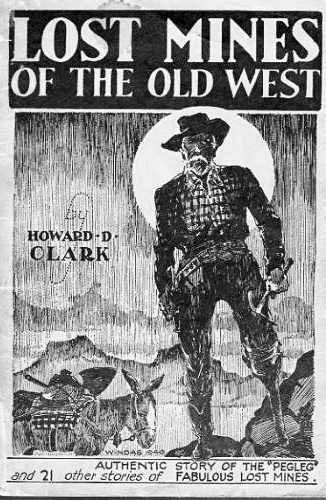
![]()
telephone: +1 (661) 242-1234
![]()
![]()
![]()
![]()